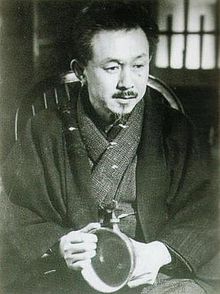Yanagi Sōetsu
Yanagi Sōetsu | |
|---|---|
 Yanagi in 1950 | |
| Born | March 21, 1889 |
| Died | May 3, 1961 (aged 72) |
| Nationality | Japanese |
| Alma mater | University of Tokyo |
| Known for | Founder of the mingei (folk craft) movement |
| Movement | Mingei (Folk craft) |
| Awards | Order of Cultural Merit (South Korea), 3rd grade |
Yanagi Sōetsu (Japanese: 柳 宗悦, March 21, 1889 – May 3, 1961), also known as Yanagi Muneyoshi,[1] was a Japanese art critic,[2] philosopher, and founder of the mingei (folk craft) movement in Japan in the late 1920s and 1930s.
Personal life[edit]
Yanagi was born in 1889 to Yanagi Narayoshi, a hydrographer of the Imperial Navy and Katsuko.[3]
His son, Sori Yanagi, was a renowned industrial designer.[3]
Career[edit]
In 1916, Yanagi made his first trip to Korea out of curiosity about Korean crafts. The trip led to the establishment of the Korean Folk Crafts Museum in 1924 and the coining of the term mingei by Yanagi, potters Hamada Shōji (1894–1978) and Kawai Kanjirō (1890–1966).
Yanagi was not an artist or craftsman himself.[4]
His theory of the "beauty of sorrow" (悲哀の美) in Korean art has been said to have influenced the development of the Korean idea of han. Following the March First Movement, Korea's independence movement in which thousands of Koreans died at the hands of the Japanese police and military, Yanagi wrote articles in 1919 and 1920, expressing sympathy for the Korean people and appreciation for Korean art.
Yanagi cautioned against the Korean independence movement.[5]
In 1926, the Folk Art Movement was formally declared by Yanagi. He rescued lowly pots used by commoners in the Edo and Meiji periods that were disappearing in rapidly urbanizing Japan. In 1936, the Japanese Folk Crafts Museum (Nihon Mingeikan) was established.
He was also working together with Onta ware.
Mingei theory[edit]
The philosophical pillar of mingei is "hand-crafted art of ordinary people" (民衆的工芸, minshū-teki kōgei). Yanagi Sōetsu discovered beauty in everyday ordinary and utilitarian objects created by nameless and unknown craftsmen. According to Yanagi, utilitarian objects made by the common people are "beyond beauty and ugliness". Below are a few criteria of mingei art and crafts:
- made by anonymous crafts people
- produced by hand in quantity
- inexpensive
- used by the masses
- functional in daily life
- representative of the region in which it was produced.
Yanagi's book The Unknown Craftsman has become an influential work since its first release in English in 1972. It examines the Japanese way of viewing and appreciating art and beauty in everyday crafts that include pottery, lacquer, textiles, and woodwork.
Yanagi was editor of Kōgei ('Crafts'), the journal of the Japanese Folk Arts Association, issued between 1931 and 1951.[6]
Legacy[edit]
In 1984, Yanagi was posthumously awarded the Bogwan Order of Cultural Merit, the first to be awarded to a non-Korean.[7]
Yanagi was a considerable influence over the likes of potter Bernard Leach, sculptor Isamu Noguchi, and architect Bruno Taut.[3]
References[edit]
- Yanagi, Soetsu (1989). The Unknown Craftsman: A Japanese Insight into Beauty. New York: Kodansha International.
- Yanagi, Soetsu (2017). Soetsu Yanagi: Selected Essays on Japanese Folk Crafts. Tokyo: Japan Publishing Industry Foundation for Culture.
- Yanagi, Soetsu (2019). The Beauty of Everyday Things. London: Penguin. ISBN 9780241366356.
- ^ Sōetsu and Muneyoshi are alternate readings (pronunciations) of the same Chinese characters.
- ^ Cotter, Holland (16 December 1994). "ART REVIEW; From Japan, Paintings To Go, but With Charm". The New York Times. Retrieved 23 July 2019.
- ^ a b c Rawsthorn, Alice (2018). Design as an Attitude. Zurich, Switzerland: JRP | Ringier. ISBN 978-3037645215.
- ^ Aso, Noriko (13 April 2009). "Mediating the Masses: Yanagi Sōetsu and Fascism". In Tansman, Alan (ed.). The Culture of Japanese Fascism. Duke University Press. p. 139. ISBN 978-0-8223-9070-1.
- ^ Nakami, Mari (2011). In Pursuit of Composite Beauty: Yanagi Soetsu, His Aesthetics and Aspiration for Peace. Trans Pacific Press. p. 116. ISBN 978-1-920901-34-9.
- ^ Gosling, Andrew (2011). Asian Treasures: Gems of the Written Word. National Library of Australia. p. 71. ISBN 978-0-642-27722-0.
- ^ 야나기 무네요시 전. jungle.co.kr (in Korean). Design Jungle. Retrieved 29 September 2018.
